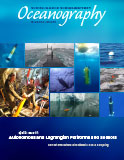Article Abstract
The Arabian Sea circulation is forced by strong monsoonal winds and is characterized by vigorous seasonally reversing currents, extreme differences in sea surface salinity, localized substantial upwelling, and widespread submesoscale thermohaline structures. Its complicated sea surface temperature patterns are important for the onset and evolution of the Asian monsoon. This article describes a program that aims to elucidate the role of upper-ocean processes and atmospheric feedbacks in setting the sea surface temperature properties of the region. The wide range of spatial and temporal scales and the difficulty of accessing much of the region with ships due to piracy motivated a novel approach based on state-of-the-art autonomous ocean sensors and platforms. The extensive data set that is being collected, combined with numerical models and remote sensing data, confirms the role of planetary waves in the reversal of the Somali Current system. These data also document the fast response of the upper equatorial ocean to monsoon winds through changes in temperature and salinity and the connectivity of the surface currents across the northern Indian Ocean. New observations of thermohaline interleaving structures and mixing in setting the surface temperature properties of the northern Arabian Sea are also discussed.

